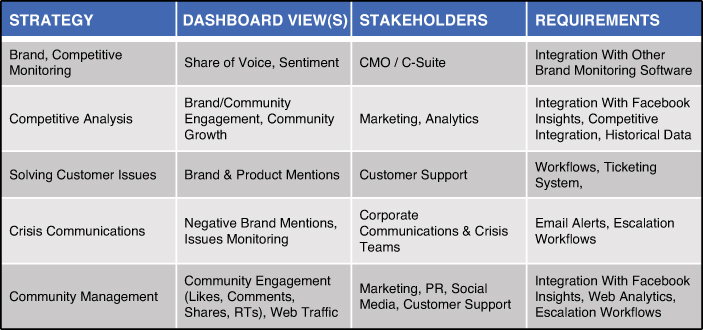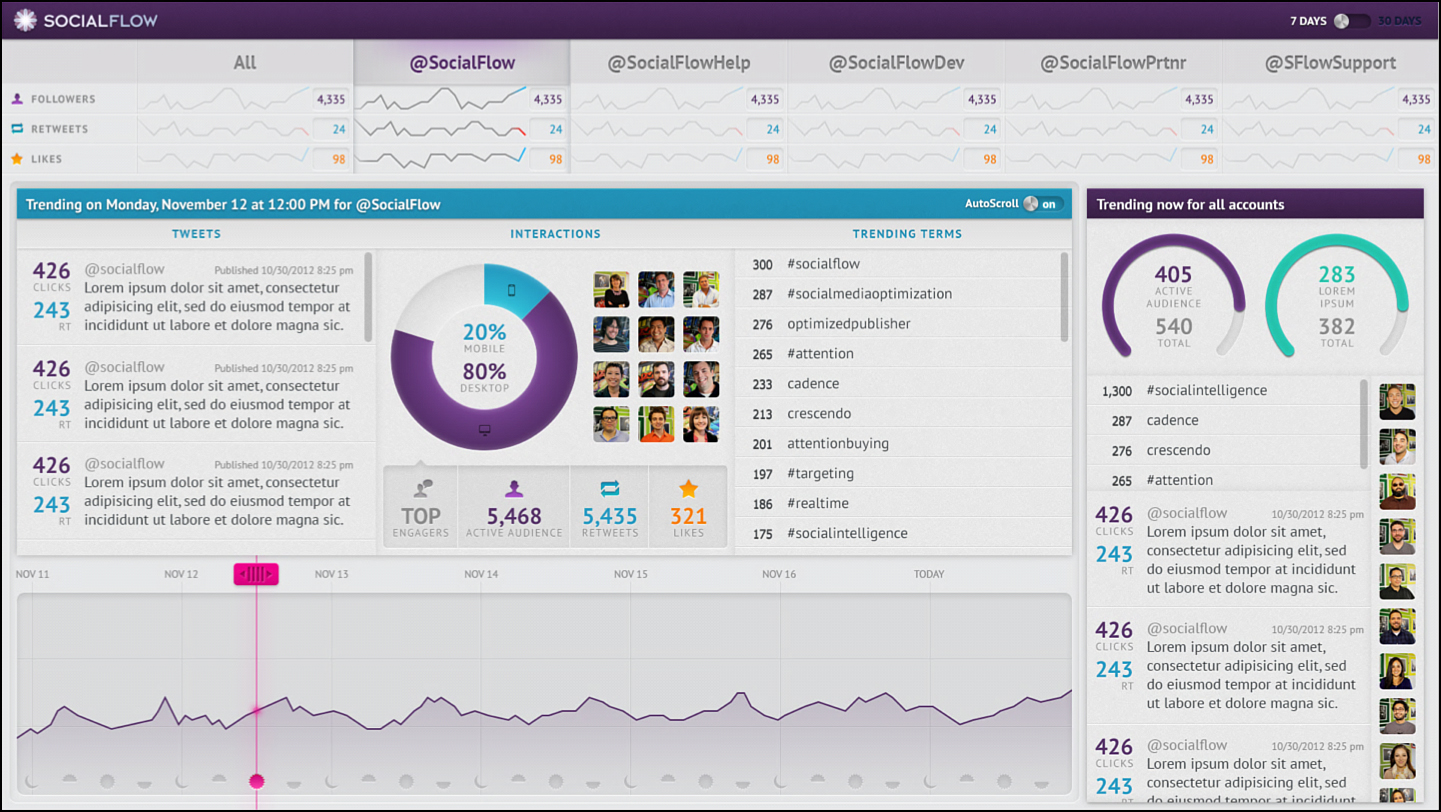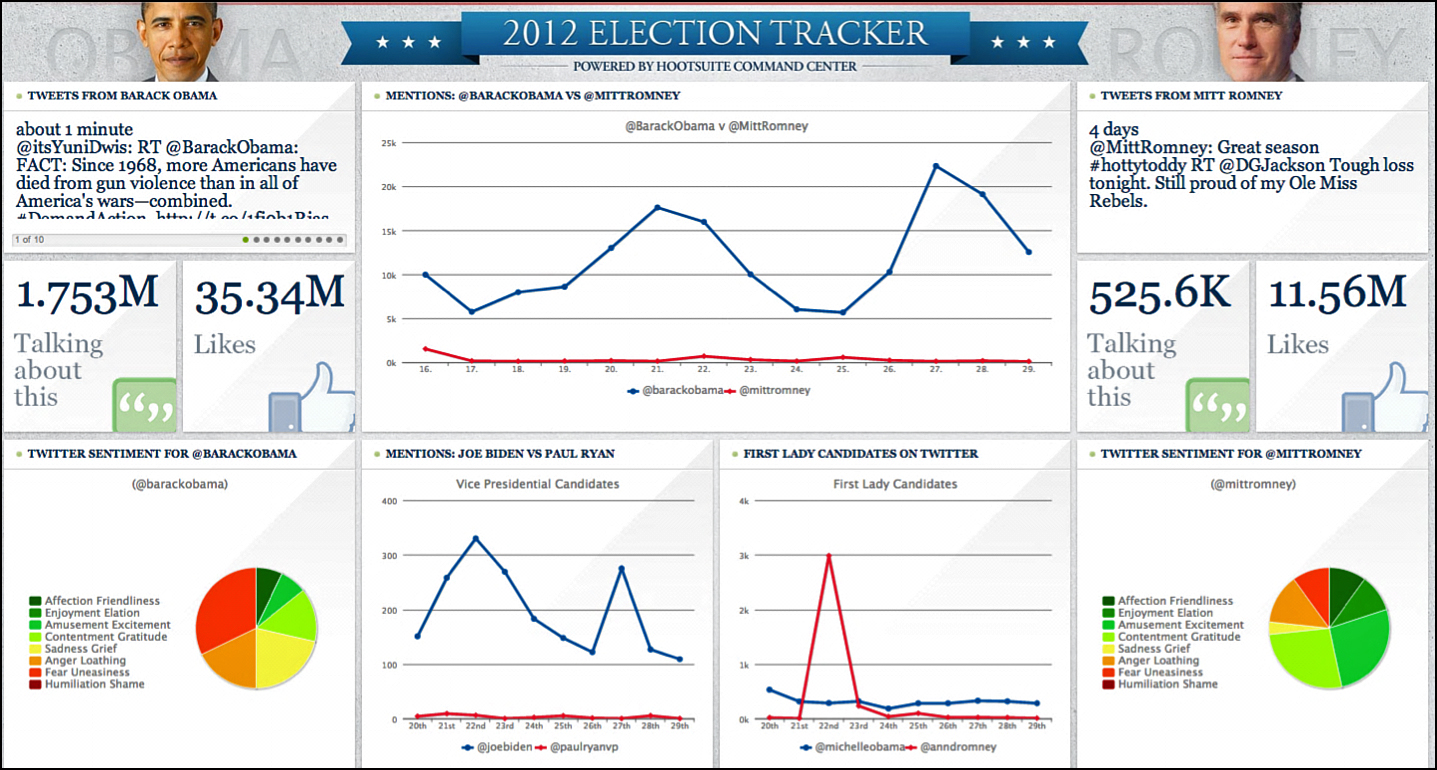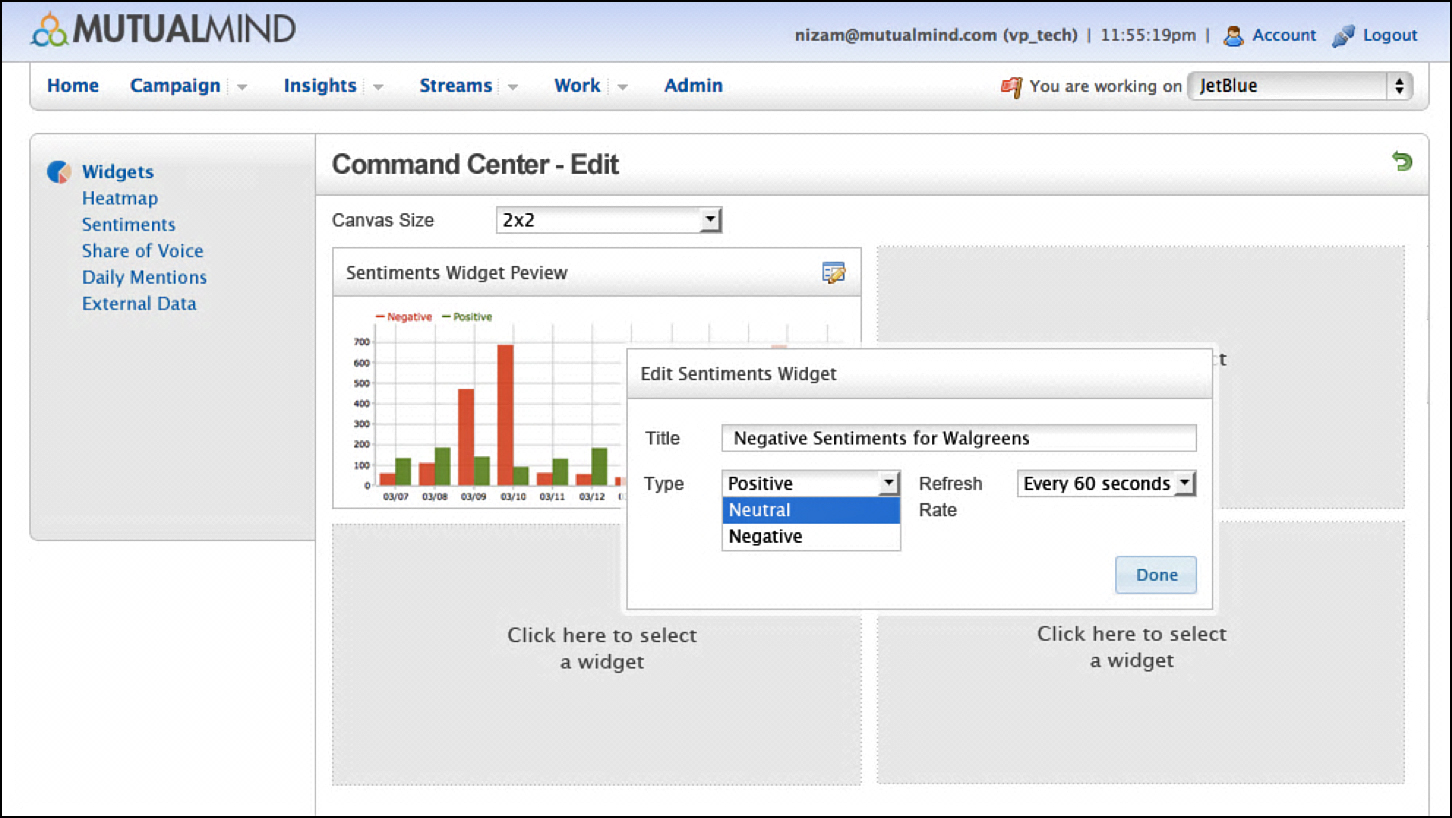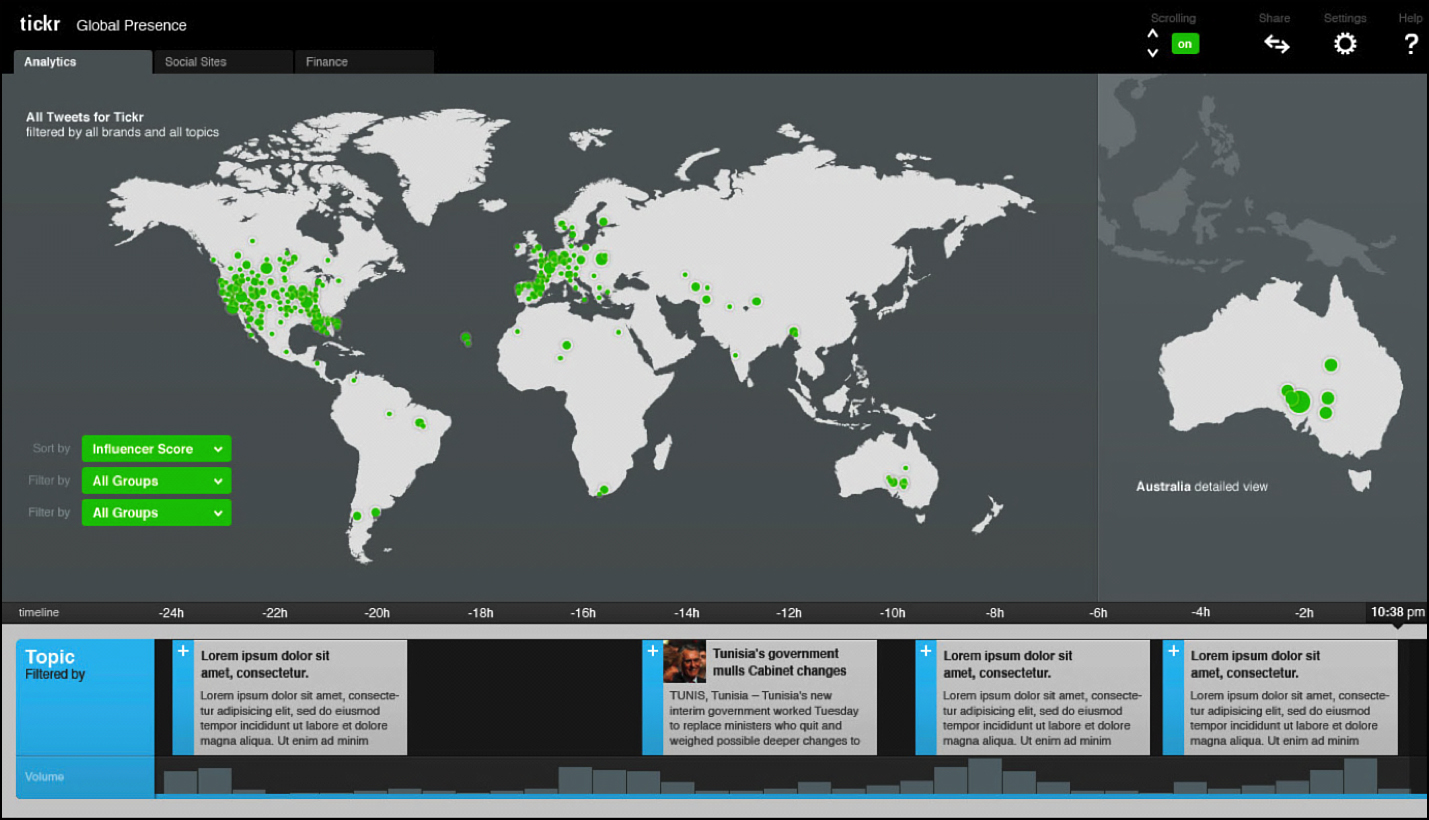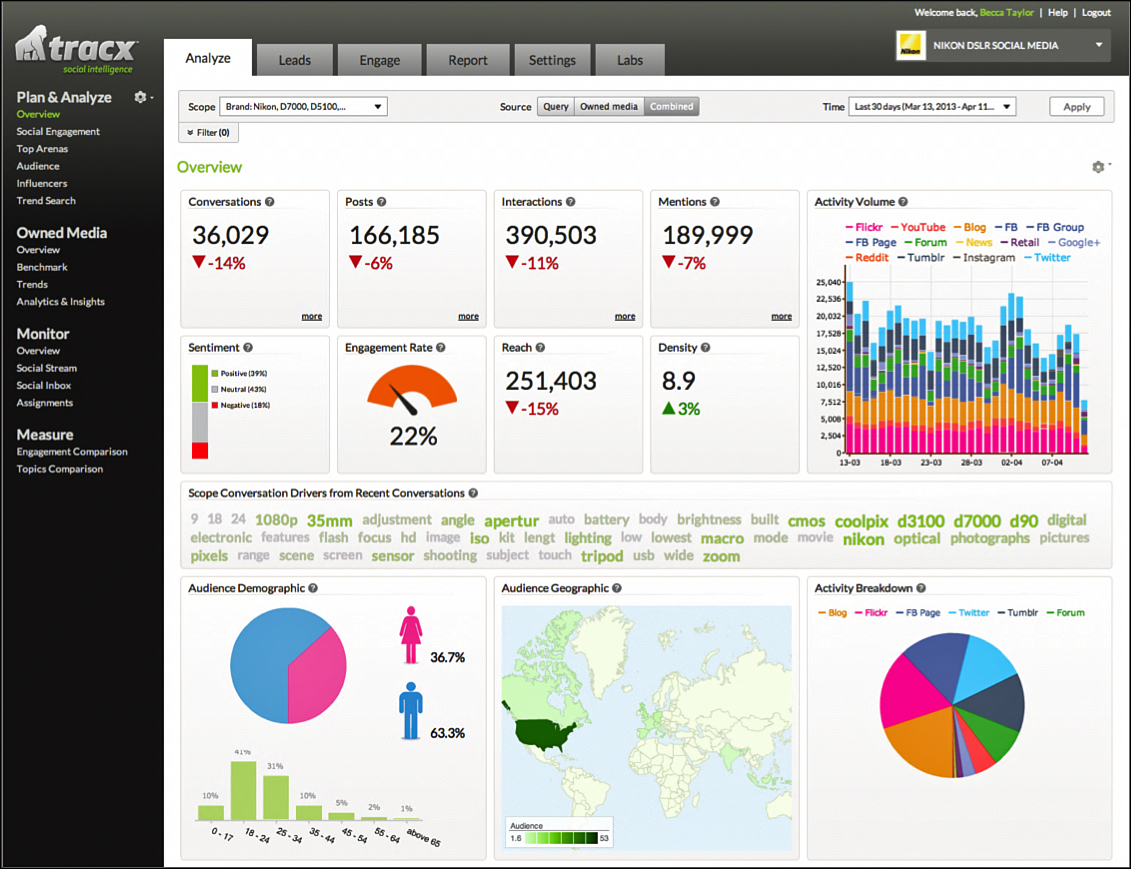5. Building Your Social Business Command Center
“Tweetable Moment: Listening to customers and not taking action is worse than not listening to them at all.”
—#nextmediaco
There is a scene from the 2002 Matt Damon movie, The Bourne Identity, in which several high-ranking CIA officials at the Pentagon are tracking Jason Bourne’s every move through satellite and GPS and displaying it on several large screens. They basically want him captured or dead before he reaches the media and exposes Operation Treadstone. The room is filled with data scientists and analysts who are updating Bourne’s movements in real-time and passing that information to hired mercenaries who are on the ground hot on his trail.
Of course this is just Hollywood, but scenarios similar to this actually exist.
The North American Aerospace Defense Command (NORAD) is a bi-national United States and Canadian organization responsible for ensuring air sovereignty and air defense of North American airspace and for monitoring against potential threats to both countries.
Some of these warnings include the monitoring of man-made objects in space and the detection and warning of attacks against North America whether by aircraft, missiles, or space vehicles.
I spent eight years in the U.S. Marines, so I can talk about NORAD all day long. And though I am certainly glad that we have them protecting us citizens from UFOs and such, this chapter is more focused on how brands, large and small, are using similar command centers to monitor “brand” conversations and how you can use them to engage with customers.
A Social Business Command Center is a dedicated area (either virtual or in a physical space) where a brand’s social media or customer service team can monitor real-time conversations about the brand and its products as well as engage in conversations with influencers, customers, prospects, and the media. Whether it’s a Pentagon-like setup, a few LCDs in a conference room, or virtual dashboards manned by community managers and support agents in various offices, the Social Business Command Center can acquire real-time intelligence and help you make informed business and marketing decisions.
To give you additional context and a slightly different point of view, Jeremiah Owyang, Analyst at the Altimeter Group, defines command centers as the following:
A command center is a physical space where companies coordinate to listen and engage their market in social channels to achieve business use cases in marketing engagement, customer care, risk management, or operational efficiency of coordination and contact center deflection.
Command centers can be used to solve a variety of business challenges, such as managing crises, solving customer problems, or listening for trending topics so that your brand can capitalize on real-time content marketing. However, you must first have a well-documented plan of action so that you can stay laser-focused on what it is you are trying to achieve as you build and launch one. This includes ensuring you have alignment from all your internal stakeholders, documented keywords and phrases that you will be monitoring, technology selection, processes/workflows, and reporting frequency.
The Strategic Importance of a Social Business Command Center
Before you launch your command center, it’s important to ensure that you have the right goals and objectives, buy-in and support from internal stakeholders, as well as the budget needed to make this financial investment because it’s not cheap. The following are eight use-cases why your business should have a command center. You can use this information to create your proposals and answer questions from upper management—especially the executives who have financial authority.
1. Listen: This one is the no-brainer. Several of the technology platforms that power command centers pride themselves on their listening capabilities. They have software that scrubs the Internet and captures all mentions of your brand in forums, blogs, Twitter, Facebook, YouTube comments, Instagram—you name it. It then provides reports that measure share of voice, volume of mentions, sentiment, community growth, engagement metrics, and so on. Just like any relationship, whether online or in real life, most of what you should do is listen.
2. Action: What’s the point of listening if you aren’t prepared to take action? Ask any married couple how important this is. Most will tell you that it’s imperative in relationship building and nurturing. At least my wife thinks so. Deploying a command center gives you the opportunity to find relevant conversations about your brand and then allows you to add value to the conversation by participating. If you aren’t prepared to add value to the discourse, you might want to rethink your strategy or postpone it until you are ready to do so. This is especially important for customer service teams and them having the autonomy to solve customer issues quickly and efficiently.
3. Community: When you listen to the conversation and add value to it, you and your brand become trusted members of the community. And as Seth Godin wrote in his book, Permission Marketing, over 11 years ago, you can then “ask permission” to market your products and services to them. The same holds true today. Both Facebook and Twitter spent years building their communities before they decided to monetize them, and today they are both doing extremely well.
4. Brand Advocacy: Friends, fans, and followers are great, and it sure looks good in a PowerPoint presentation when you have a lot of them. But what’s next? Your goal should be to turn those friends, fans, and followers into brand advocates. Chapter 4, “Empowering Employees, Customers, and Partners to Feed the Content Engine,” not only pleads the case that you need to create brand advocacy that can help you feed the content engine, but it also shows you how to do it, step-by-step.
5. Content: Command centers can also give you the opportunity to capture trends that are happening in real-time and allow you to insert your brand into the news-cycle if it makes sense to do so. In this case, you wouldn’t necessarily be monitoring “brand mentions” but rather topics that are trending from the people who follow your brand in social media. Though “content is king,” the ability to create the right content, at the right time, in the right channel, and to the right customer is where the true value is. Command centers can give you this ability.
6. Innovation: Companies such as Dell, GiffGaff, Lego, and Starbucks rely heavily on the community for innovation. They are not only “listening to the conversation,” but they are taking the collective feedback from their communities and taking action by innovating their products and services based on customer insight. Not only does this strategy help you build products that people will actually buy, but it also creates a sense of advocacy because your community feels emotionally invested in your brand and its products.
7. Research: Command centers can also work as real-time focus groups or be used as research initiatives. Many of these technology platforms pull in customer data like basic demographics and psychographics; as well as give you insights into customer pain points about your products or services. In 2011, Clemson University launched their Social Media Listening Command Center specifically to support their Creative Inquiry program. Undergraduate students involved in this program can use the command center to research topics of their choice under the guidance of faculty mentors and get credit for it.
8. Customer Support: Many command centers today are managed by customer support agents who have the responsibility of listening specifically for “brand mentions” and then solving customer issues quickly and efficiently. Many times these command centers also have built in processes, escalation workflows, and ticketing systems, much like a traditional call center operation.
Once you decide on your goals and objectives for your command center operation, you will have to think internally about all the moving parts that will bring it to life. This includes the actual strategy—what problem are you trying to solve for? You will also have to determine the various dashboard views, which is really the “eye candy” of the entire operation. You will have to coordinate with the right stakeholders to determine who needs to be involved to make the command center work to everyone’s benefit. This may include various marketing and PR teams, product or brand teams, IT, customer support, and country/regional marketing teams as well. Lastly, you will have to document all your internal and external requirements, which is really the engine of the command center technology.
Figure 5.1 is an example matrix of what your strategy can look like as you plan to launch your command center.
The Social Business Command Center Framework
So far in this chapter, I have provided several use-cases that you can adopt if you are thinking about building your command center. And the truth is, you should build a command center whether one use case makes sense for your business or all of them make sense. Figure 5.2 gives you a high-level and general visual framework of how a command center can work within your company:
• Monitoring: The command center staff monitors online conversations and determines which conversations to respond to and what kind of content to create.
• Content Creation: Reactive content is usually managed by community managers or customer support staff. Proactive content creation is managed and executed by the content marketing team (community managers, designers, copy writers, and producers) or even a team of brand journalists.
• Publish: After the content is created and shared in your brand’s owned media channels, it can be published to paid media channels if applicable.
• Amplify: After it’s published, the content is spread across your brand’s social media ecosystem for the community to amplify, resulting in earned media for your brand.
• Measure: In some cases, the content is measured and iterated in real-time to take advantage of what’s trending within the news cycle.
How to Build a Social Business Command Center
Building a command center isn’t like building Legos. There aren’t sets of instructions that are going to walk you step-by-step to show you which pieces go where. It’s more like a puzzle and often requires you to force-fit certain pieces to make it work. Every company is different. Culture, marketing philosophies, go-to-market strategies, and technology deployments are unique to each organization and are often times dynamic. Whenever new leadership revolves in and out of a company, you can find yourself taking two steps back with each step forward. The good news is that I have developed a five-step framework that will not only make your life a little easier, but will also help you stay on track as you plan to launch a command center for your brand.
Discovery
If you have ever worked in consulting, you already know that the first step in any project plan is the discovery phase. In this phase, you have to do an internal audit and document your findings related to your internal stakeholders—marketing, public relations, customer support, IT, operations, and others. This alone can take some time, particularly if you work for a large and matrix-structured company.
After your stakeholders are identified, you have to get a firm understanding of their current responsibilities and set expectations with them very early on about what their roles will be in the command center deployment. These discussions should also involve asking for any financial support you need from each of these teams. Partnering with the IT team will be critical in this process for a variety of reasons. First, you need to know which current technology platforms are being used for CRM, online monitoring, content publishing, and any other applications that might be used alongside your command center operation. You also have to find out if there are any existing firewall restrictions as it relates to application development and/or current contractual obligations that exist with any vendors. It’s always wise to make IT your friend and involve them in the decision-making process early on. If you do this, there will be fewer roadblocks as you go. It’s important not to work in a silo when planning for your command center.
You should also interview several leaders in your company to get a better understanding of what they perceive to be the most pressing business challenges facing the company. Which competitors are keeping your CMO up at night? What are the biggest challenges your CIO is having when deciding on technology? Ask your CEO how he or she feels social media will help elevate the brand or business. All of these conversations are going to help you frame your strategy.
Externally, you should plan to do an audit of all of your social media activities. This should include documenting how many Facebook, Twitter, YouTube, and other accounts that your brand is responsible for, which ones are active, and/or which ones can be consolidated and shut down. A content audit is just as important. This involves looking at each of these communities and measuring the past and present content performance of each. Part of your internal stakeholder audits consist of determining who is responsible for managing each of these communities.
Planning
After you have all of your interviews and information documented, you need to begin planning your launch. The first thing you need to do is determine which technology vendor(s) to partner with. The next section gives you an overview of several vendors you can consider using that have productized command center offerings successfully.
Deciding on the taxonomy of key terms you want to monitor is a part of the planning process. Obviously, you want to monitor for brand-related terms, but there are several other things to consider as well. If your brand name or products are difficult to spell, you should also monitor for common misspellings. Competitive terms should also be on your list as it allows you to get a better understanding of the conversation volume and share of voice that your competitors have over your brand or vice versa. Industry terms are just as important. If you work for Nike and basketball shoes are a strategic initiative for your brand, you could consider monitoring “basketball shoes” as an industry term. You are able to extract the data and see of those “basketball shoes” conversations, how many also mentioned Nike, or better yet, your competitors. If your percentage numbers are lower than your competitors’, then you know you need to work on your brand positioning and content strategy.
Simultaneously, you need to start talking with your internal stakeholders and come to an agreement on a measurement plan. As discussed in Chapter 2, “Defining Social Business Strategy and Planning,” one of the biggest challenges that most companies face is that they aren’t measuring their social media efforts or that everyone internally is measuring it differently. Either way, this is not the way to go. You must establish what you want to measure and deliver a reporting schedule that everyone is brought into, ensuring that it’s a collective decision between you and all of your stakeholders before the command center launches.
Training is critical to the launch plan. Whenever you deploy a new set of technologies, the learning curve is usually massive, so having a solid training plan should help alleviate many of your challenges. Part of your training should include “how” to use the command center (set up accounts, running reports) but also contain process and workflows so that community managers know how and when to escalate social conversations to customer support and/or crisis teams.
After you have sorted out the technology situation and the terms for monitoring and created the training and workflows, you have to define your team’s new roles and responsibilities. This includes creating monitoring schedules for your teams and then determining who is responsible for running reports, creating content, and engaging directly with your customers.
Implementation
Implementation happens the day you turn on your command center. You might already be engaging with your customers in two-way conversations, but now you will have additional data about what they are saying as well as what the larger community is saying simultaneously. This gives you better context on how you want to respond.
One of the key things to remember when you launch is that you should document any and all best practices, key learning points, or insights that you gain and share that knowledge with your internal stakeholders. It is particularly important to share these best practices with the teams that support your initiative financially. It helps validate their financial investment in case you need to ask for additional funds in the future.
Companies like Dell and Gatorade made a big splash about launching their command centers mainly because they were among the first to do it. This resulted in some great media attention, and they are often cited in white papers, blog posts, and various industry reports. But as command centers are slowly becoming the norm, you might not want to spend your time trying to get external coverage and instead focus on listening and engaging with your customers.
Reporting
One of the first things you will find out after the command center launches is that you get a line of new stakeholders that want you to run reports for various product launches and initiatives. It happens all the time, and it requires you to iterate your reporting schedule. You should already have a report lined up that you will send to the CMO and marketing leadership. This report should include data points around share of voice (brand and competitive) and brand sentiment. Your marketing teams might find this data useful, but they want more granular metrics such as content performance, community growth, community attrition, and general engagement. Digital campaign marketing teams might want all of the above and “campaign-specific” data points such as captured leads, conversions, and click-through rates.
Kaizen
Kaizen, meaning constant improvement, is a Chinese term that has been adopted by Japanese carmakers such as Toyota. Toyota uses this concept to help eliminate waste on their assembly lines so that workers are more efficient and productive when performing specific tasks. In this case, it’s important to remember you should constantly be trying to improve—not just the technology, workflows, and the terms you are monitoring, but also the way you generate content and engage with the community. The great thing about launching a command center is that you can acquire data at your fingertips that will help you create content that’s more meaningful and relevant and that will help you build stronger relationships with your customers.
Social Business Command Centers in Action
Several brands, including NGOs and universities, are finding value in deploying command centers. Following are a few organizations that are using them within a physical location for a variety of reasons.
University of Oregon
Oregon has one of the highest nationally ranked college sports programs. With 18 varsity teams, the Oregon Ducks are best known for their football team and track and field program, which has helped to make Eugene become known as “Track Town, USA.” Their top-ranked football team regularly plays in high-profile, nationally televised games and draws the attention of social media users everywhere—resulting in one of the largest social communities with well over 500,000 fans on Facebook and Twitter combined.
In 2012, Oregon was the first university to launch a command center. They call it the QuackCave, and it’s used to share news and content from social media channels including the @GoDucks and @QuackCave Twitter accounts. Additionally, the QuackCave serves as a hub for all of the athletic program’s social media communications where staffers distribute promotional content through Twitter, Facebook, YouTube, Instagram, and other social networks. They also monitor fan conversation to answer questions and interact with passionate students, alumni, and random followers, especially when the Ducks are playing in prime time. It’s currently manned during workday hours by a rotating cast of students and athletic department staff.
Cisco Systems
Cisco Systems launched their command center in October 2012, which they call their Social Media Listening Center. They have six touch-enabled LCD screens showcasing real-time information about Cisco conversations happening in social media. The command center’s visualizations are powered by one of Cisco’s core products, the Cisco Interactive Experience Solution, which uses the network as the platform to transform customer experiences with interactive digital media. The solution allows you to deliver interactive content and information in real time, improving loyalty and revenue, while increasing efficiencies in business processes. The platform is managed in the cloud and is a Linux-based solution that has a proprietary Enterprise-grade browser that allows for data-rich visualizations to be loaded onto the screens.
Today, Cisco currently views and monitors all Cisco brand-related conversations, their suite of products, competitive conversations, and share of voice. They also find and monitor which influencers are talking about which products, and they have also deployed specific event-based command centers for past events like the London Olympics and the Cisco Collaboration Summit 2012, where conversations were monitored and viewed in real time.
Clemson University
In 2012, Clemson University also built their Social Media Listening Center (SMLC) with support from Dell and Salesforce Radian6. Its command center enables students and faculty to monitor thousands of online conversations about organizations, brands, products, and services on a global scale and in real time.
The SMLC has six large LCD screens featuring different content and data visualizations. Salesforce Radian6 provides the platform to listen, discover, measure, and engage in conversations across the Internet and captures more than 150 million sources of online conversations from Facebook, Twitter, YouTube, LinkedIn, blogs, and other online communities. The Radian6 summary dashboard provides a graphic display of social media content to convey sentiment, share of voice, trend information, geo-location, and other demographic data.
American Red Cross
In 2012, the American Red Cross launched their Digital Operations Center. They currently use it to monitor and respond to real-life disasters that threaten human life. Most recently they used their command center to monitor and respond to victims of Hurricane Sandy. A team of 23 Red Cross staffers and volunteers monitored more than 2.5 million #Sandy mentions in Twitter, tagging 4,500 for on-the-ground follow-up.
The Digital Operations Center aggregates social media conversations from numerous sources to include Twitter, Facebook, and blogs and delivers all the data into visualizations that are easy to track and view. In a 2012 InformationWeek article, Red Cross President and CEO Gail McGovern said that the Digital Operations Center gives the Red Cross a better idea of what’s happening on the ground during a disaster, helps the organization detect and track trends, and helps connect affected individuals to resources they need. The command center is modeled after Dell’s Social Media Listening Command Center, which Dell opened in December 2010. They were one of the first companies to build a command center.
Gatorade
In 2010 Gatorade launched its Mission Control Center in partnership with Radian6 and IBM to track conversations customers were having about their sports drink. The command center features six large-scale LCD screens where they monitor a visualization of tweets that are relevant to Gatorade; tracking terms relating to the brand, including competitors, as well as its athletes and sports nutrition-related topics. They also measure blog conversations across a variety of topics that display how viral those conversations are across the social media ecosystem. They display detailed sentiment analysis around key topics, product launches, and campaign initiatives.
Their Mission Control is physically located in a conference room right in the middle of Gatorade’s marketing team, and the monitoring dashboards are available for employees to view directly from their computers.
The New Form of Command Center Operations: Real-Time Marketing
Although many of these command centers discussed above are used to react to conversations, there is a new form of command center that gives you the ability to be proactive, monitor “what’s trending” within your communities, and then create content that capitalizes on the real-time news cycle. Some call it the creative or brand newsroom.
Take for example Super Bowl XLVII after the lights went out during the halftime show. No one could have anticipated that this was going to happen, so planning for it would have been impossible. But there were a few brands that were able to capitalize on the power outage. Oreo was one brand that seized on the opportunity and they have now popularized this concept of real-time marketing.
“Power out?” Oreo posted to Twitter and then linked to a photo with this caption, “No problem. You can still dunk in the dark.”
The tweet was retweeted 10,000 times within one hour of the power outage at the Mercedes-Benz Superdome and has since been cited in Ad Age, Adweek, New York Times, Mashable, Digiday, and Fast Company to name a few (see Figure 5.3).
The Oreo photo was “designed, captioned, and approved within minutes,” according to Sarah Hofstetter, president of the cookie brand’s digital agency of record, 360i, in an interview with Ad Age. All the decisions were made in real time quickly because marketers and agency members were sitting together at a “mission control” monitoring what was happening during the Super Bowl.
A few other brands jumped in as well. Audi, whose TV commercial aired just before the blackout, used the power outage as an opportunity to take a soft jab at rival luxury car manufacturer Mercedes-Benz (the prime sponsor of the Mercedes Benz Superdome in New Orleans) tweeting
Sending some LEDs to the @MBUSA Superdome right now.
Another example happened in the summer of 2012. It was an exchange between Oreo Cookies and AMC Theatres Twitter accounts. Here is how it played out:
Oreo: Ever bring your own Oreo Cookies to the movie theater? #slicksnacker
AMC Theatres: NOT COOL, COOKIE. RT @Oreo Ever bring your own Oreo Cookies to the movie theater? #slicksnacker
Oreo: Fair enough @AMCTheatres, but don’t hate the player, hate the game:)
AMC Theatres: GAME ON. RT @Oreo Fair enough @AMCTheatres, but don’t hate the player, hate the game:)
In the last exchange by AMC Theaters, the community manager snapped a picture of himself with two Oreos covering each of his eyes and pointing his fingers directly at the camera insinuating that he was watching Oreo’s every move.
What’s interesting about these two brands bantering back and forth is that Oreo never tweeted directly to AMC Theaters. They did mention the word “theater” in the original tweet, but there was no @mention, which is a basic practice when purposely trying to mention someone on Twitter. The community manager at AMC Theaters was undoubtedly monitoring the term “theaters” to see if there was an opportunity for him to insert the brand into a creative conversation, and he found one. Another takeaway is that he was given the power and autonomy to create a piece of visual content on the fly and respond quickly—two important characteristics of real-time marketing.
Not Everyone’s Onboard with Real-Time
Although this new trend is gaining traction with many brands building their own newsrooms, some don’t necessarily believe the hype.
Shiv Singh, head of Digital at Pepsi, believes that creative newsrooms are just a buzzword. In a 2013 Digiday article titled, “Should Brands Have Newsrooms,” he said, “For all brands to wake up one day and have a newsroom, I wouldn’t recommend that by any means. It scares the living daylights out of me to think of if all brands had a newsroom and were culture-jacking every event.” The article goes on to say that operating a newsroom is expensive and difficult to do. This is definitely true if you consider agency resources, head count, and the technology investment needed.
Joe Lazauskas, Managing Editor at Contently, disagrees with Shiv. In a response blog post, he said that “those who push back on the creative newsroom concept are stuck imagining a newsroom from 1993.” In either case, real-time marketing is alive and well today. Virgin Mobile has its own creative newsroom, staffed by internal and agency team members, including Ron Faris, head of global marketing. According to the same Digiday article, the Virgin Mobile newsroom publishes content 12 times a week on average.
My view on brand newsrooms is straightforward. Brands cannot sit idle and wait for the news cycle before they create game changing content. They should be doing this day in and day out, no questions asked. The reality is that real-time content should only be a small percentage of your brand’s content strategy anyway; unless, of course, you are actually reporting news or your products are relevant to pop culture. That said, your brand should be prepared at all times in case the opportunity does arise to “culture-jack” the news, but understand that there must be some correlation between what’s going in the news and your content narrative, even if it’s just a small one.
Real-Time Marketing Technology
Although most command centers today are reactive and used to monitor for brand mentions, a few platforms are positioned to lead the way for real-time marketing deployment, SocialFlow being one. SocialFlow is a content publishing and ad platform that uses real-time analytics and a predictive algorithm to publish content at the right time when customers are actually paying attention (see Figure 5.4). They have two core products, Cadence and Crescendo, which I discussed at length at the end of Chapter 1, “Understanding the Social Customer and the Chaotic World We Live In.” If you use their software, you also have the option to use their real-time command center dashboard that surfaces trending topics (as well as topics that will start to trend) from your brand’s set of followers as well the entire social web. Their features include
• Real-time conversations among an audience or a segment you determine
• Content ranked or scored against an audience based on real-time interest and relevance
• Specific views of all of a company’s brand’s followers (Likes, retweets, community growth) in aggregate and the ability to compare these data points with other accounts (including competitors)
• Trending topics, accounts, and hashtags
• Total interactions with the accounts of a company’s top engagers and where they are located geographically
In August 2013, the Dachis Group announced their Real-time Marketing Platform, a scalable real-time marketing solution that makes it easy for brands to find and join the trending conversations of their customers, prospects, and advocates.
The platform engine solves several challenges that you may be facing when attempting to execute real-time content marketing:
• Targeting: The hyper-fragmentation of media has made it extremely difficult to find your target audiences using most forms of traditional media monitoring and measurement. This platform finds the live conversations of your most coveted audiences so that you can create content in an environment where you know you have your audience’s attention.
• Attachment: Most brands struggle to adjust their marketing processes and workflows from a world of a few major initiatives a year (product launches, events) to a world with thousands of opportunities to engage every single day. This platform can help you identify the trends that you should pursue today so that you can join the conversations with an added value piece of content.
• Measurement: Real-time conversations move too quickly for traditional marketing analytics. This platform is built on top of Dachis’s social analytics engines and provides the detailed insights and reporting marketers need to be effective.
According to Jeffrey Dachis, founder and CEO of Dachis Group, real-time marketing is the discipline that finally allows brands to get in on brand relevant conversations happening in the highly fragmented media universe we now live in, and with big data analytics, we can deliver targeted scale and efficiency for brands in ways that were unthinkable before (dachisgroup.com). Figure 5.5 is an example of their real-time dashboard.
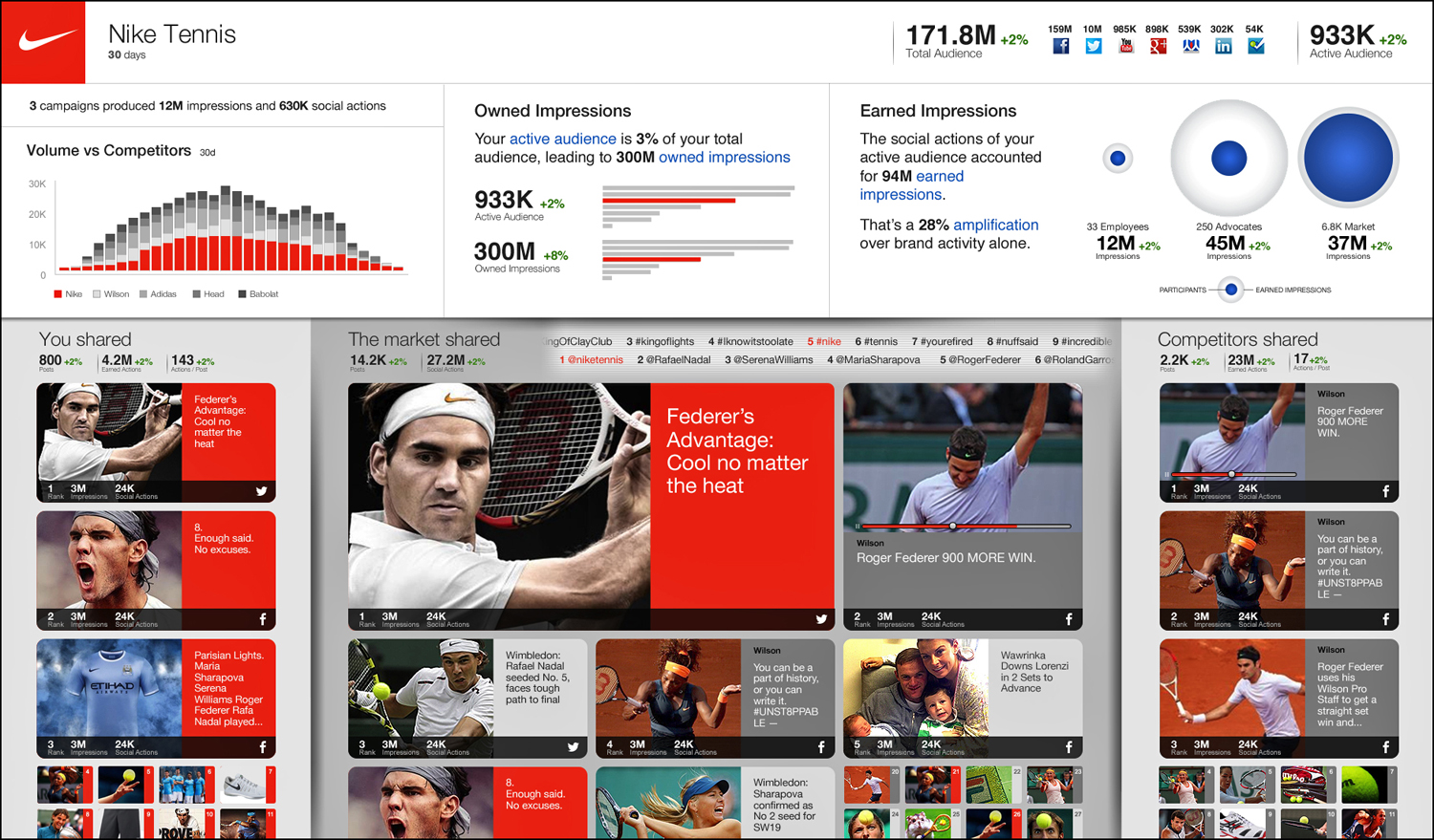
Figure 5.5 The Dachis Real-time Marketing Platform surfaces trending topics about or related to the brand.
Although it’s not necessarily a dashboard or command center, Trendspottr is another platform that can help you surface real-time, trending content. TrendSpottr is a web service that identifies real-time trends happening in social media for any search term or topic of interest. The algorithms used by their platform are tuned to identify real-time trends at their acceleration point to provide early and predictive insights. TrendSpottr identifies trends and trending information hours or even days before they become “popular” and reach a level of general awareness. These early insights can keep you “ahead of the curve” to prepare for and predict market and social behaviors, consumer preferences, impending crises, and real-time marketing.
In 2013, Bit.ly, a popular URL shortening service, launched a set of social application programming interfaces (APIs) that includes real-time search, attention spikes, and metadata about URLs being shared across the social web. Their real-time search platform (Rt.ly) allows you to run a query and get back the top URLs and stories that are trending. Queries can be specific phrases such as “Sons of Anarchy” or filtering by criteria with stories about news that people are reading about in Austin, for example.
The platform works similarly to Twitter’s Trending Topics feature. If you go Rt.ly, you find a number of filters that let you search all Bit.ly links by city, social network, keywords, languages, and even topics. You can also “create a story” for a particular search, for example “Apple iPhone,” that displays a report with a map showing click-through rate, geographical distribution of readers, link referrals, related stories, top domains, and more.
There are only few vendors in the space that offer real-time monitoring of trends, content performance analytics, and audience analysis. This will certainly change as real-time marketing become prominent and as more brands will demand diversity of services from the technology vendors they work with.
Vendor Spotlight: HootSuite, MutualMind, PeopleBrowsr, Tickr, and Tracx
The following vendors have productized their command centers and focus more on “brand and industry monitoring” for reactive purposes, which is just as important if not more important than real-time, opportunistic marketing purposes.
HootSuite
In 2012, Social Media Management Software Company HootSuite launched their 2012 Election Tracker. The tracker monitored both the Barack Obama and Mitt Romney campaigns up through and after the election. The dashboard as seen in Figure 5.6 monitored all the conversations on Facebook and Twitter about each candidate in real time. It not only displayed the latest tweets from both parties, but also pulled in any mentions of either candidate as well as the conversation sentiment.
The dashboard also displayed Facebook data including the number of Likes as well as how many people were talking about both candidates. Last, the dashboard displayed trending graphs of spikes and valleys of online conversation.
HootSuite’s main component of their command center offering is the multi-platform KPI (Key Performance Indicators) visualization for social analytics. This extends the current HootSuite dashboard by providing optimized, live data feeds and visualization that can be configured for large screens (TVs), PCs, and mobile devices. You can also add data feeds from other providers, such as web analytics or social CRM applications. Their platform also works with HootSuite’s existing enterprise engagement solution and mobile applications so that their customers can monitor real-time conversations from the browser and/or mobile phone.
MutualMind
The MutualMind Command Center (MCC) integrates social listening, multilingual sentiment analysis, pre and post-collection filtering with real-time response, advanced visualization, and workflow management. Their platform delivers 360-degree visibility by combining listening analytics from all major social media channels (Facebook, Twitter, LinkedIn) with visual and location data analytics from social sites such as Instagram, Foursquare, and Tumblr.
In addition, real-time event tracking is supported via MutualMind’s Authentrix series of metrics, measuring influencer impact and giving you the ability to quickly gauge marketing promotion success and ROI. Their features include:
• Modules: Customizable, widget-based views with advanced visualizations for social data (see Figure 5.7).
• View builder: The ability to create custom command center views using drag-and-drop widgets from a library of templates.
• Business data integration: The ability to create new widgets in user interface, which import and overlay business data with social and marketing data.
• ROI Calculator: A built-in, customizable, data-driven ROI calculator.
• Analytics: Text, location, and visual media analytics; brand and competition comparisons, share of voice, activity and multi-lingual sentiment heat maps, topic discovery, authentic reach and authentic influence of brand advocates and influencers, social channel analytics, and target audience listening.
PeopleBrowsr
PeopleBrowsr’s Command Center product displays many of the same data points as those command centers mentioned previously. One of the main differences is that their dashboard screens are interactive. Figure 5.8 shows that if you click any of the data points on the dashboard, a popup displays with all of the conversations tied to that specific data point.
Additionally, they have an interactive, global heat map that displays the same conversations globally. Their platform is fully integrated with Kred—an influencer platform that enables you to identify influential people within interest-based communities. Kred scores are generated by observing a social network user’s content, who it reaches, who acts upon it, and whether the user relays the content of others.
Similar to HootSuite, PeopleBrowsr has an engagement platform with Twitter conversations broken down in streams: @mentions, @replies, and searches. It also gives you the ability to interact with your community and influencers in real time.
Tickr
Tickr describes their product as “a 360° view of your brand and business within social media and beyond.” As such, you shouldn’t think of Tickr as limited to social media monitoring, but more as a way to help understand the impact of social media on other parts of the business—web traffic, news mentions, even online sales data. The key value proposition of Tickr is the way the platform brings together all this data in one place with a clear and simple interface. Tickr is currently used by project managers to track projects in real-time, C-level executives to get a holistic view of how various parts of their organizations relate to each other, agency account managers to track brands and campaigns, and operations centers to monitor IT systems status. Figure 5.9 is one dashboard illustrating the conversations that are happening about your brand globally, with an interactive heat map indicating the volume and frequency of these conversations.
One key feature that sets Tickr apart from other platforms is that the initial set up takes literally minutes. Basically, all you do is either enter a simple keyword string or an advanced Boolean search query that you want to begin monitoring. And as much as I stressed that you need to collaborate with the IT organization, the Tickr platform is a SaaS-based solution (Software as a Service), so there is no engineering or IT support required. You can quickly configure reporting screens that combine social media, news, blogs, campaign metrics, and enterprise reporting in one interface. (And for those of you who can’t quite let go of paper, there is an export to PDF option as well.) Obviously this saves time and money compared to hand-created reports, but a key strength of Tickr is that it allows managers to see correlations between data across all kinds of sources—correlations that might otherwise go unnoticed (such as an influencer who retweets the brand which sends hundreds of people to the website who then make product purchases).
Tracx
Tracx is a social intelligence software platform that supports various job functions including marketing, customer support, sales, customer insights, product management, and even HR. Tracx integrates social monitoring and listening with full engagement, as well as social analytics and reporting. Tracx also mines social conversations to find people in the active buying phase and automatically categorizes them based on where they are in the buying process (awareness, research, opinion, purchase, or loyalty).
This tool also allows for monitoring social conversations across a broad range of social sites including Twitter, Facebook, LinkedIn, Google+, YouTube, Instagram, Flickr, Tumblr, Reddit, Foursquare, community forums, news sites, blogs, and even popular retail forums such as eBay and Amazon.
One the most powerful features about the Tracx platform is the capability it provides its users to pivot on social data in real-time by topic, network, demographics (age, male/female), geography, sentiment, and so on. This will help you shift your content strategy in real-time by monitoring the performance of your marketing activities and how it’s affecting the broader conversation about your brand. Tracx also monitors across both owned social media (corporate Twitter accounts, Facebook pages, and so on) and earned (social mentions by third parties on all the sites mentioned here) and lets users easily toggle between them or view them combined. Figure 5.10 illustrates their command center technology.

